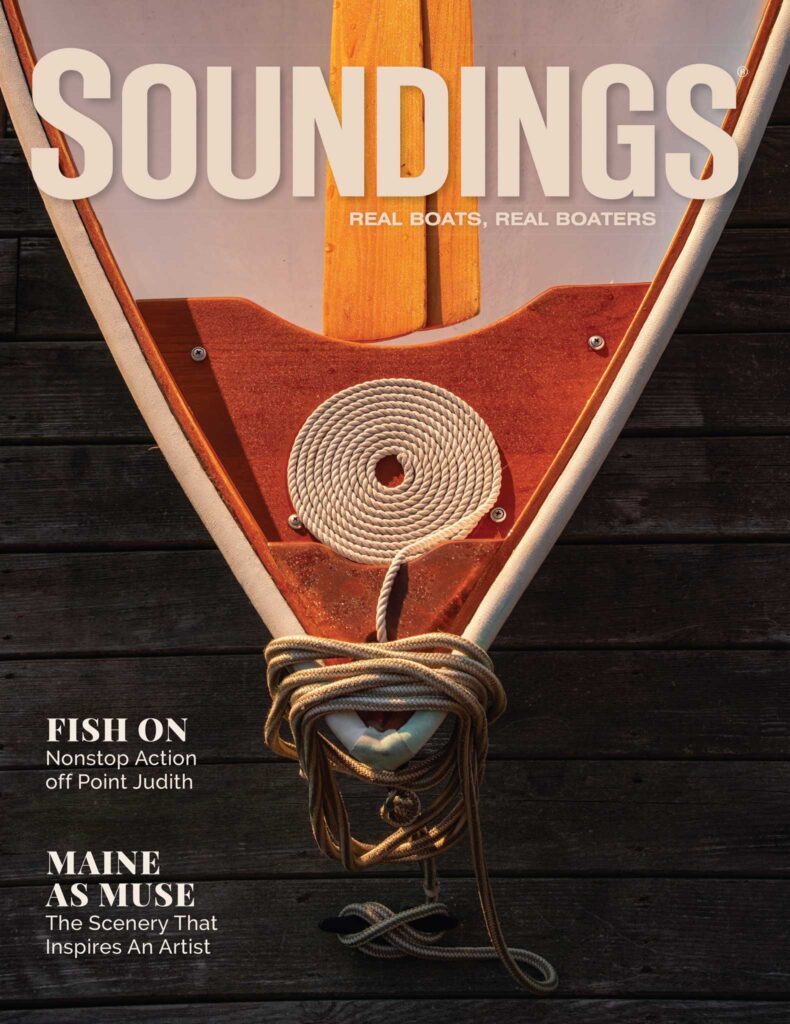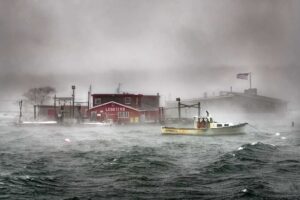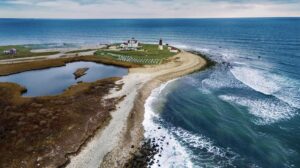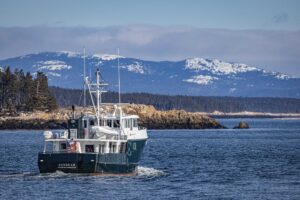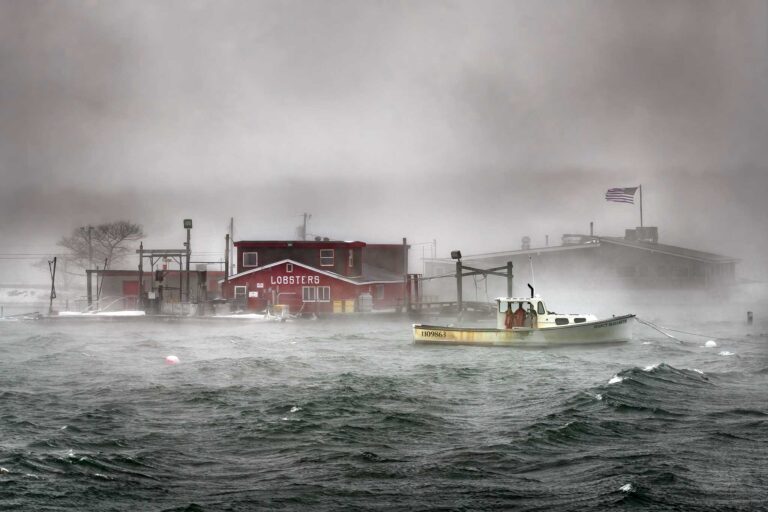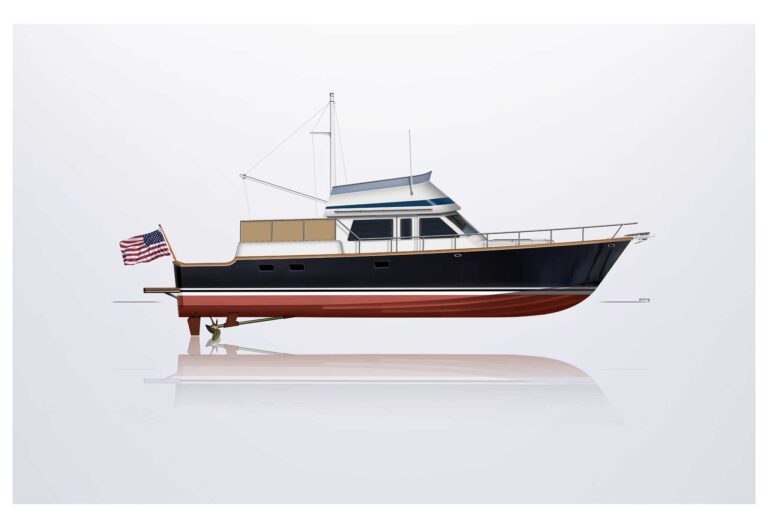Just past daybreak at Wells Cove Landing, an offshoot of Kent Narrows on the Chesapeake Bay, the morning sounds are a peculiar mix—water slapping the bulkhead, the Route 50 highway drone, the whir of a fishing reel, an osprey keening overhead, laughter, a conversation in Spanish, another in Vietnamese. Through it all comes the intermittent rumble of wheeled coolers under tow from the parking lot to the boats: Island Queen II, Shirley B III, Miss Violet, Off Da’ Hook.

Dozens of anglers have traveled from as far away as Philadelphia, New York City and Washington, D.C., to spend the day among a small group of Black captains with the collective experience of generations of watermen. Much of their knowledge is gleaned from decades working the bay in the traditional fisheries of crabbing, oystering and clamming. But, starting in the 1950s, these watermen began to diversify into head boats, offering people from all walks of life an affordable day of fishing and, in the process, creating a unique enclave of boats and businesses run by Black captains.
Today, the question is, can this tradition continue?
Montro Wright steps off the Shirley B III and strides down the dock. At 81 years old, his gait is a tad stiff, but he still walks like a man who feels daylight burning. He’s headed to Off Da’ Hook, the boat run by his son, 62-year-old Lamont Wright, to confer about some aspect of the day to come—whether there’s enough bait, which passengers or crew haven’t shown up. Aboard Off Da’ Hook, Lamont’s sons, Sedrick Cooper and Tomaz Davis, work with Shamar Austin to settle in the customers, lifting their rods, coolers and gear into the boat, and guiding them to open seats.
Next week, 27-year-old Sedrick will be sitting for his U.S. Coast Guard 50-ton license—a ticket that will enable him to run his father’s boat. And though Lamont has every confidence in Sedrick and fairly bursts with pride when he talks about him, Lamont also admits, “I think I’m more nervous about this test than he is.”
At least six of the early generation Black captains have died, including—just this past July at age 92—Warren Butler, who was one of the first to start head boat fishing here. “Now, my father is the oldest living captain,” Lamont says. Many of the current captains are second-generation, but they’re all in their 50s, 60s and 70s. “None of us got as many in front of us as we got behind us, you know what I’m sayin’? That’s why it’s important that my vision comes true.”

That vision, Lamont says, is to create a way to help young men and women pay for the Coast Guard’s licensing class (which costs $1,200 to $1,500), give them the opportunity to earn the hundreds of hours of sea time they need to obtain their tickets, and generally help pave the way for the younger generation to follow their fathers’ footsteps.
“Where do we go from here?” he says. “If we don’t get some youth in us, we’re going to die. I just don’t want the Black captains of the Chesapeake to die.” If Sedrick can become a captain, he says, “It’ll be three generations at the same time, if it’ll be God’s will.”
By 7:15, the boats are full, and one by one they pull smartly off the dock. Sedrick takes the helm of Off Da’ Hook. With Lamont beside him offering occasional quiet guidance, Sedrick guides her through the skinny passage under the Narrows’ two bridges and into the Chester River.
Built in 1956 in Deltaville, Virginia, Off Da’ Hook is 50 feet LOA with a 14-foot beam, powered with a 300-hp Cummins. She’s licensed to carry 30 people and three crew. Head boats are so named because customers pay by the head—a day on Off Da’ Hook is $60 per person, not including (if needed) rod and rig rentals, bait, beverages and tips for the crew.

Her cabinhouse extends nearly all the way aft, providing shelter from the weather, as well as a head and a sink for washing up. Outside, benches stretch across the transom and fore and aft between the cabin house and the hip-high coaming. This is where customers set up their day of fishing, shoving coolers under the benches where they sit and watch the water and their lines.
Each boat is a bit different; Montro’s 50-foot Shirley B III, licensed to carry 49 passengers, has a long, open cockpit covered with a flat roof, and bucket-type seats inside the coaming around the cockpit perimeter. A cabin forward houses the helm, as well as his-and-her heads. Powered with a 525-hp John Deere, the boat originally was built as a U.S. Navy launch. Montro took it to a Crisfield, Maryland, boatbuilder to revamp it for head boat fishing.
Until then, he’d been working a traditional deadrise, predominantly clamming but also oystering and crabbing. He added head boat fishing to his portfolio after getting his captain’s license in 1970. Later, when clamming and oystering went bust, this diversification proved prescient.
“When you work the water, you try to do whatever there is to do on the water,” he says. “My mother and father used to work in the processing plants, so I was raised up around the water. After school, we used to come down and help. When I was 12 or 13, I started out oystering on Saturdays, me and my brother, Andrew.”
At 16, he and Andrew started working the water full time. At the Queen Anne’s County Watermen’s Story Swap in 2017, Montro described how he got his first boat, a 34-footer that cost $650. He had a note for $275 but was still short, and nobody in his family had any money to lend him, so he pawned his car. “Me and my brother started working the boat, and after that we paid everyone back, and the rest is history. But it was a hard, hard struggle to get your first boat. You just had to have somebody to help you. You just couldn’t start by yourself.”
That reality, he says, hasn’t changed. Today, he reckons Shirley B III would cost at least $250,000—a nearly impossible hurdle for a young person coming into the business. “You almost have to grow up doing this. You gotta really fall in love with it,” he says.

His son, Lamont, admits that he did not love it. In fact, his primary career was not fishing; he worked as a corrections officer and police officer for Anne Arundel County, then became a building inspector and school bus contractor in Queen Anne’s County. But in 2012, he bought Off Da’ Hook and started head boat charters on weekends. By 2017, he retired from the county and came full circle, back to the water, fishing full time.
“I started on the water when I was about 12,” he said at the Watermen’s Story Swap. “I was not a waterman. He [Montro] used to tell me everything is not for everybody, and that’s a true statement. I hated being on the water. But we were kind of forced to work, and that was a kind of work. He had a clam rig at that time, and we would get up at 3 a.m. and we would go out, but he would have us home in time to take a shower and then go to school.”
His father, he says, “is made of steel. That man was my backbone. I wouldn’t be what I am without him.”
This morning, Off Da’ Hook is headed toward a spot Lamont fishes off Eastern Neck Island when he hears Montro on the VHF radio.
“Where you at, Dad?” he asks. “Red buoy? I’m gonna stop where I was last night. I’m gonna try this first till I come out.”
A minute later, his phone rings. “Hey, Dad,” he says. “All right, I’m gonna head out there then,” and he instructs Sedrick to head for Love Point, the northern tip of Kent Island. There, they drop the hook in about 24 feet of water amid a small gathering of head boats, with Shirley B III close aboard.
As soon as the engine stops, lines fly into the water. Unlike sportfishing boats that troll for species like rockfish and bluefish, head boat fishing is bottom fishing, so while a captain may move from one place to another to get on the fish, once there, the boat stays put. These anglers aren’t here for trophies or one or two slot fish; they’re here to catch as many fish as they can to drop them in coolers and take them home for a week’s worth of dinners. Bloodworms are the primary bait, and pan-size spot and perch are the predominant target. In this way, it’s an extremely accessible form of fishing that’s easy to teach someone of any age or background, and that costs little to get into.
The best places, Montro says, are the old oyster beds, where fish gather at the structure provided by rocks and old shell.
“From those years of oystering, we know where to fish,” he says. “When you’ve been on the water for 60 years, there’s not much about the water you don’t know. You can always learn something, but there’s not much you don’t know.”

Those years also provide a long perspective on how the fishery has changed. Used to be, Montro says, trout (weakfish) and croaker were also common. Now, it’s pretty much down to spot and perch, and of those, the fish are smaller. The state has put a 50-fish limit on spot per angler, but Lamont says competition for the fish is still heavy. Sportfish boats that troll for rockfish, for instance, frequently find the head boats when they’ve limited out, and they’ll fish for spot, too, to use as bait.
By midmorning, a kind of gentle rhythm is established on Off Da’ Hook. A pleasant southerly is building, keeping everyone cool. The radio is grooving SiriusXM’s Heart & Soul—“adult R&B from yesterday and today.” A small group of Vietnamese anglers, who have staked out the transom, are laughing and chatting as they bring in one fish after another. Up at the port bow, a cluster of Spanish-speaking fishermen are working. Elsewhere, groups of three and four sit side by side, young and old.
This kind of culture, gender and age mashup is entirely common among the head boats, Lamont says, although the larger church groups of 25 people or more who used to come before the pandemic have yet to really return. Still, once the state lifted the 10-person maximum that was imposed early in 2020, the pandemic year was one of his busiest. The head boat’s layout made it easy for fishing groups to maintain distance, and a day on the bay was a relief from lockdown.
George O’Donnell, a former Kent Narrows waterman and Queen Anne’s County commissioner who now works in Maryland’s Department of Natural Resources, says the niche that these watermen have built is unique.
“I didn’t realize till after I started working for the state that the largest group of minority seafood harvesters in the state, and perhaps even the East Coast, is right here in Queen Anne’s County,” he says. “It’s just a great group of watermen who have really filled a necessary void for that type of fishing, and we’re proud to have it in the Kent Narrows.”
It’s such a singular group that when S. Torriano Berry, who was teaching film production at Howard University in Washington, D.C., first went fishing with Butler, he returned repeatedly to film Black Captains of the Chesapeake, which aired on Maryland Public Television in 2014.
While the anglers do their thing, Off Da’ Hook’s crew stays busy. Lamont is a stickler for cleanliness; he expects the head to be cleaned at least every half hour, bait bags to be sorted and counted, buckets and rods to be stacked by color and type. If someone isn’t having luck, one of the crew will make sure the rig is correct and “on the bottom.”

In between the work, Sedrick pores over his notes and a Coast Guard book, heavy with yellow highlighter. Though he has been on and around the water since he was a youngster, spending summers with his father and grandfather, Sedrick moved to Buffalo, N.Y., with his mother and ended up attending SUNY Buffalo State College where he majored in early childhood education. After graduating, he went to work as a teacher and then for the Head Start program in Buffalo.
“I never thought I would be a captain, to be honest with you,” he says. “But now that I’m here, it kind of feels inevitable.” He came back, he says, to “keep it in the family, keep the business going. I felt like I had to do it, really. I watched him build his business from nothing, get his own boat.” Working with his father and grandfather, he adds, “is a real enjoyable experience. I get to learn from them every day.”
By 2 p.m., Lamont calls out: “All right, y’all! Get your last one in, time to go!” The crew hustles to clean up, the fishermen pull their lines, and Sedrick calls, “Go ahead and hit ’er, Pops!” Lamont fires up the Cummins, hauls the anchor, and turns the boat toward the narrows a few miles south. He hands the helm to Sedrick and talks to him all the way through the narrows, which is intensely busy now with sailboats, powerboats, kayaks, even small boats that are anchored and fishing—all maneuvering in a squirrely 4-knot flood-tide current.
When Off Da’ Hook comes into Wells Cove Landing, the wind is pushing hard one way and the current the other. The nearby dock is studded with pricey recreational boats whose owners are hanging out at the neighboring dock bar. It’s a tight, tricky landing, and Sedrick nails it.
“There you go,” Lamont says, as the boat snugs gently into the pier. “Perfect.”
This article was originally published in the October 2021 issue.

